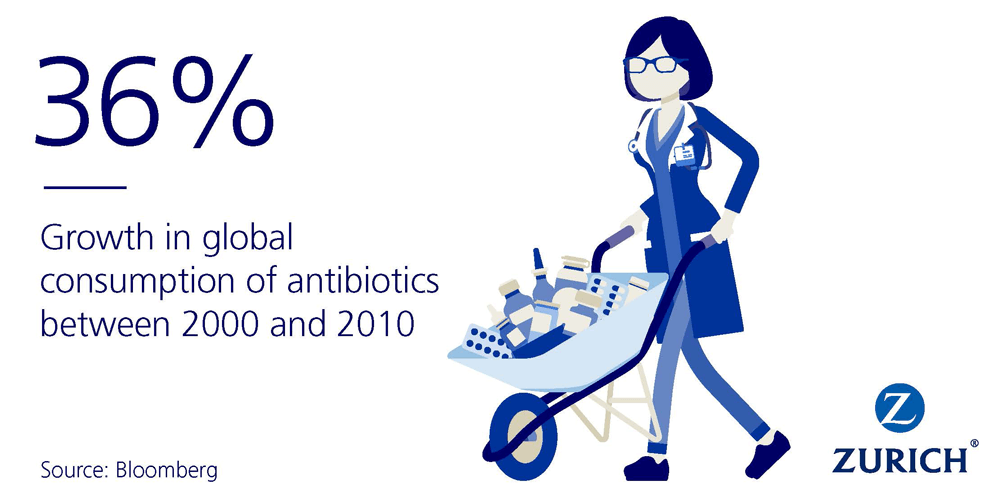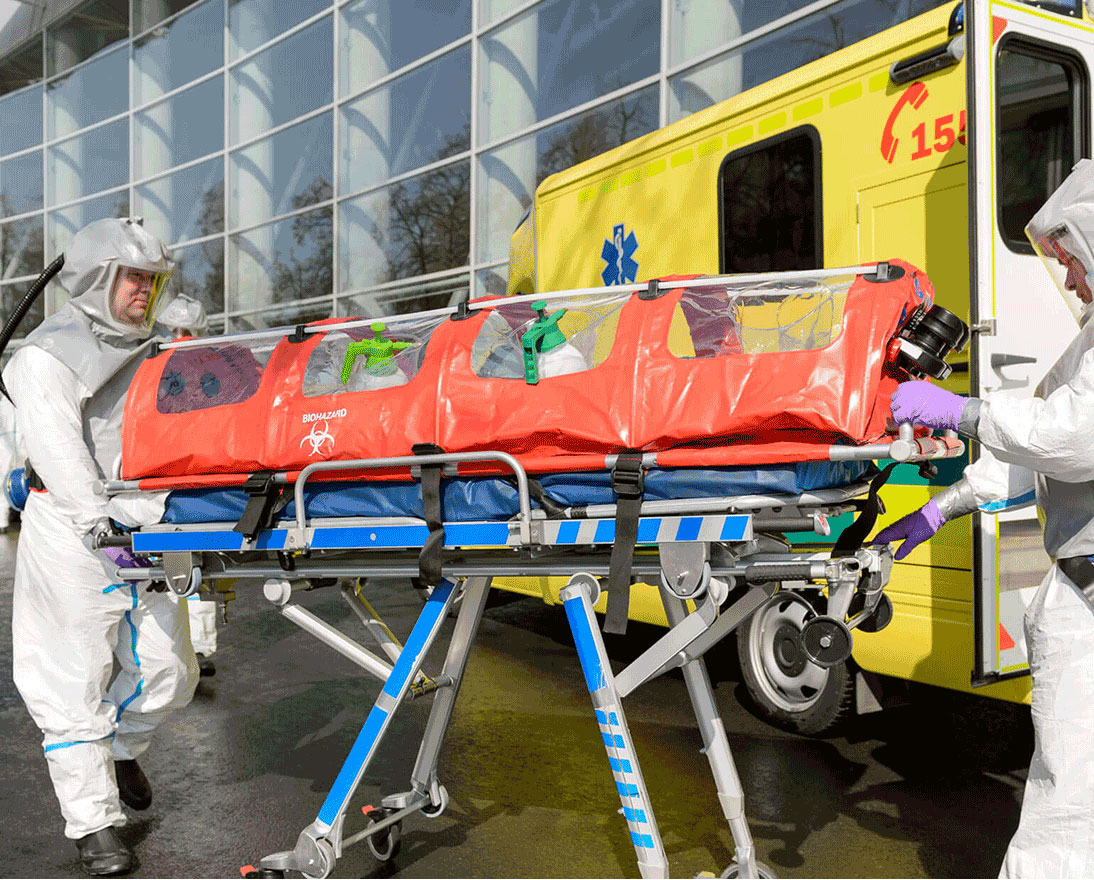Superbugs, pandemics and synthetic biology put biological risks on the C-suite's agenda
Global risksArticleApril 8, 2019
This science isn’t fiction. The race is on to protect public health, and the global economy, against biological risks.
Too much of a good thing is rapidly becoming a bad thing.
Antibiotics have saved untold millions of lives over the past 90 years, but rampant overuse—by humans and in agriculture—threatens to lay the groundwork for a catastrophic public health emergency. And the looming crisis owes as much to human nurture as to nature.
“Our ability to respond to biological risks is being hampered by carelessness,” warns the World Economic Forum’s Global Risk Report 2019. “Misuse and overuse of antibiotics continues to undermine the efficacy of one of the most important medical countermeasures ever discovered.”
The threat of these superbugs highlights the growing biological risks around pandemics, the preparedness gap and the lack of governance around synthetic biology. This situation demands public-health officials coordinate a global response and that business leaders build resilience to biological risks into their operations across many areas.
Antibiotics
Responsibility for increased resistance to once potent treatments doesn’t just lie with doctors too eager to dispense drugs. Pharmaceutical companies are investing less in antibiotic research. From 2010-2014, the number of new antibacterial drugs approved by the U.S. Food and Drug Administration was less than one-third of what it was three decades earlier (Source: National Center for Biotechnology Information). In fact, no major new groups of antibiotics have been discovered in decades.
Agriculture is another source of antibiotics overuse. In the U.S., an estimated 80 percent of antibiotics are fed to animals, often to encourage growth. The result is increased human resistance to antibiotics through animal products in the food chain and also animal waste in the soil, water and air.

“Antibiotics have saved many, many lives. The challenge is that they’ve been overused in livestock production and over-the-counter prescriptions,” says John Scott, Head of Sustainability Risk at Zurich Insurance Group. “Many organisms have become resistant to antibiotics. Then, in recent years, very few new antibiotics have been discovered. That means this transformational medicine is going to disappear at some point in the future.”
That specter is already appearing. Drug-resistant infections kill an estimated 23,000 in America alone and 2 million people are sickened annually, according to the U.S. Centers for Disease Control and Prevention. The cost of a standard tuberculosis protocol costs $17,000 over nine months, but treating an extensively drug-resistant strain is more than 30 times as expensive and can take three years (Source: CDC). The World Health Organization says 558,000 people around the world developed multidrug-resistant or rifampicin-resistant strains of tuberculosis in 2017.
Yet the overuse of antibiotics and the corresponding rise of resistant bacteria is among our least analyzed threats, with inconsistent data, no consensus on collection, and no comprehensive list of bacterial strains and their distinct resistance mechanisms.
“Drug-resistant infections already kill hundreds of thousands a year globally, and by 2050 that figure could be more than 10 million,” says Jim O’Neill, chairman of the Review on Antimicrobial Resistance, who predicts the economic costs of antibiotic-resistant infections could hit $100 trillion by 2050.
That burden won’t be limited to industries with direct exposure, like healthcare, farming and food. Cleaning companies and medical device manufacturers are among those who could also face legal and financial jeopardy. Medicare has already cut payments to hospitals with high rates of patient infection. Other healthcare insurers might follow suit. The seriousness of this risk should be on the radar of all risk managers and corporate boards.
Pandemics
The importance of building resilience to biological risks has potential ramifications that go beyond public health. The economic implication of a pandemic is enormous, and it’s growing.
The World Health Organization maintains a list of “priority diseases” that risk becoming pandemics due to a lack of countermeasures. In June 2018, six of the eight diseases on that list saw outbreaks, any of which had the capacity to claim thousands of lives and create major global disruptions had they spread widely.
In 2003, SARS infected 8,000 people and killed 774. The outbreak cost the global economy an estimated $50 billion. The MERS outbreak in South Korea four years ago infected 200 people, killed 38, and cost $8.5 billion.
Surging levels of travel, trade and connectivity mean that exposure is not confined by geography. Many factors contribute to the frequency and reach of viral outbreaks—including high-density living, deforestation, climate change and mass human displacement. Models have shown an outbreak can make its way from a remote village to major cities around the world in less than 36 hours.
“The world is badly under-prepared for even modest biological threats. We are vulnerable to potentially huge impacts on individual lives, societal well-being, economic activity and national security,” the Global Risks Report states. “Progress has made us complacent about conventional threats, but nature remains capable of ‘innovating’ a pandemic that would cause untold damage.”
The practicalities of operating amid a pandemic should be an essential consideration for companies, Scott insists. That means conducting a rigorous risk assessment that identifies potential interruptions in the supply chain and challenges to business continuity.
"On a practical level, boards should use a pandemic or a biological threat as a scenario to play though your own business-continuity management or crisis management," Scott says. "It's about understanding how bad the risk can be for your particular business and what you can do to mitigate those risks."
Synthetic Biology
Amazing opportunities are being created almost every day in synthetic biology as scientists discover new ways of producing pharmaceuticals, chemicals, fuels and electronics. However, these opportunities come with significant risks, especially since governance around synthetic biology is thin, according to Scott.
"We're very vulnerable to the fact that synthetic biology is very poorly regulated at the moment," Scott says. "There's very little governance as to how these technologies are developed and what they are used for."
Even more troubling is the possibility of terrorists acquiring this technology and using synthetic biology as a weapon.
Synthetic biology is part of the foundation of the Fourth Industrial Revolution and these new technologies are going to produce great advances for society and for business growth, Scott says. An important role for business leaders and corporate boards in building resilience to biological risks is to advocate for appropriate governance of biotechnology.
“Specifically, companies engaged in developing these technologies, need to think about the protocols that govern the environment of the technology itself, and manage those risks,” Scott says. “For all other organizations, we need to educate ourselves about biological risks so we can protect our customers and the society that we live and work in.”





